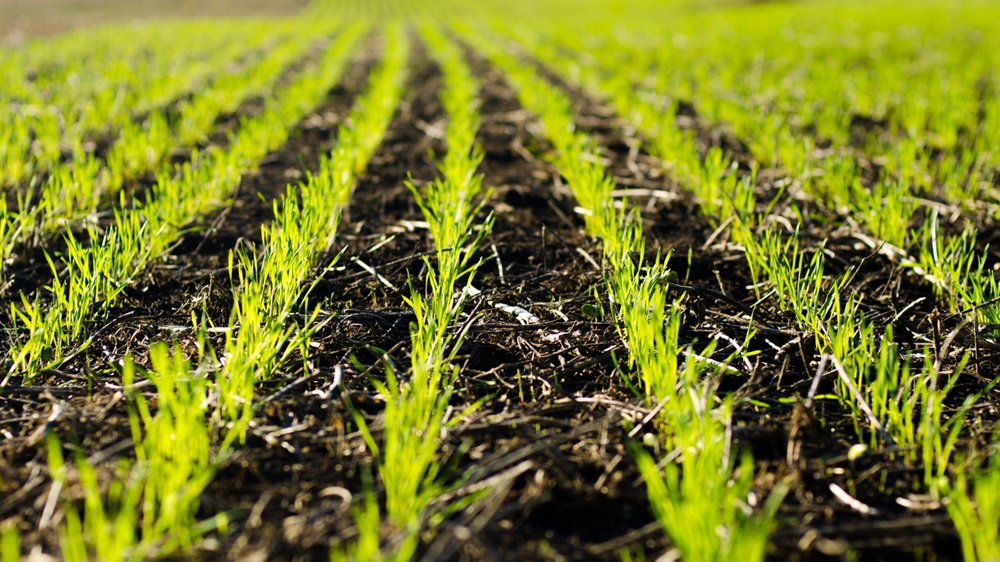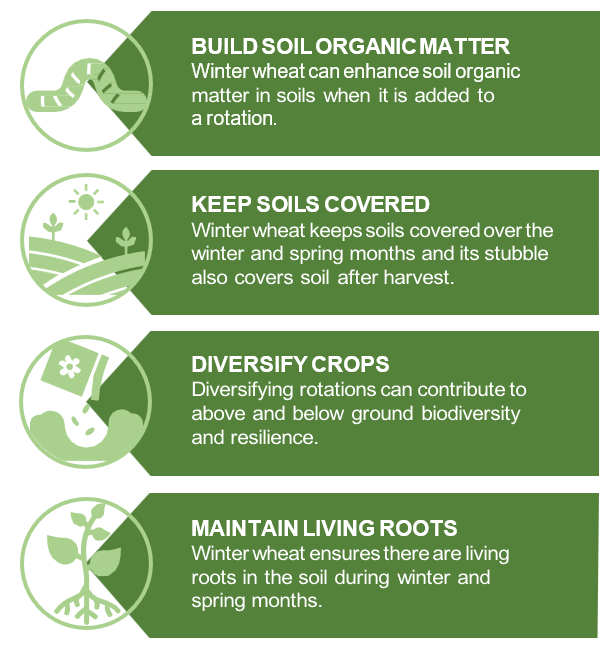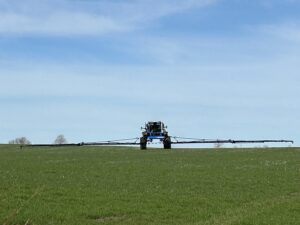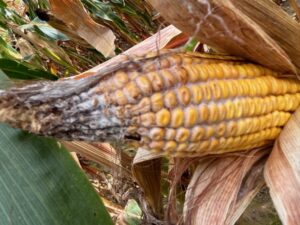Winter wheat
A POWERHOUSE IN SUSTAINABILITY AND PRODUCTIVITY

ONGOING RESEARCH SHOWS THAT CROP ROTATION IS AN IMPORTANT CONSIDERATION IN GROWING SUSTAINABLE AND PROFITABLE CROPS — and winter wheat is one of the crops that growers should consider including. With a list of benefits, including improving soil health and quality, pest management, and boosting overall productivity, winter wheat is a strong choice for Ontario grain farmers to include in their rotation.
Winter wheat acreage has fluctuated over the past two decades in Ontario, with a recent high of 1.1 million seeded acres in 2021, according to Statistics Canada. While there can be initial barriers and costs to growing winter wheat, the positive outcomes it can produce for the entire crop production system and the environment are observed over time. These outcomes include enhancing crop yields, soil organic matter, soil structure, nutrient availability, soil biodiversity, and mitigating plant pests and pathogens. Maintaining Ontario’s winter wheat production into the future will be critical to building resiliency in cropping systems and achieving productivity goals.

SOIL HEALTH BENEFITS
The practices and management systems that improve soil health are wide-ranging and regionally specific in their implementation and the outcomes they produce. Farmers in Ontario have implemented several best management practices (BMPs) to enhance the health of their soils, including diverse rotations, cover cropping, reduced tillage, and improved nutrient management.
Diversifying rotations is not traditionally adopted to achieve soil health outcomes. Farmers adopt a diverse rotation to avoid depleted soil quality and manage pathogens, pests, and weeds. However, according to the Comprehensive Assessment of Soil Health — The Cornell Framework, diversifying rotations is increasingly explored as a strategy for its soil health benefits. Planting winter wheat in crop rotations contributes to upholding soil health principles, including building soil organic matter, keeping soils covered, diversifying crops, and maintaining living roots. Farmers across Ontario put these principles into action, which are further expanded upon in Ontario’s Agricultural Soil Health and Conservation Strategy, New Horizons.
Including winter wheat in a corn and soybean rotation also gives farmers a larger time window to plant a cover crop such as red clover, adding nitrogen and organic matter to the soil. This additional cover crop contributes to the soil’s overall health by reducing and preventing wind erosion, keeping the nutrient-rich topsoil in place for the following year’s crop.
PRODUCTION BENEFITS
Planting winter wheat can also boost productivity in the entire cropping system. Dr. Ikechukwu V. Agomoh and his collaborators found that, within their study, that soybeans grown in three-year rotations with winter wheat and corn in southwestern Ontario produced the largest soybean yields and the greatest positive impacts on soil health indicators, likely owing to the cereal crops for enhancing carbon inputs into soil. In particular, compared with continuous soybean systems, soybean yields were 48 to 52 per cent greater for the three-year rotations with wheat and corn.
Adding winter wheat to a monoculture cropping system or two-crop rotation can also help mitigate disease, weed, and pest pressure. For example, frog-eye leaf spot in soybeans can be reduced; weeds can be controlled by providing canopy cover during later fall and early spring; and the life cycle of western corn rootworm can be disrupted by adding winter wheat to a rotation.
Farmers who want to introduce winter wheat into their rotation can sometimes face barriers to adoption, including the added costs of adapting current management systems, increased equipment demands, and short-term opportunity costs for growing winter wheat relative to higher-value crops. However, the increased profitability from diversifying a rotation, boosting yields of other row crops in that rotation, and improving the long-term health of the field and its soil can make winter wheat a profitable and sustainable choice. These benefits have been demonstrated through research led by Dr. Ken Janovicek, who found that adding wheat to a corn and soybean rotation in Elora and Ridgetown contributed to improving long-term productivity and net returns over time.
OPTIMIZING PRODUCTIVITY AND SOIL HEALTH
The Great Lakes Yield Enhancement Network (YEN) program allows farmers to develop customized approaches to optimize their winter wheat production and overcome barriers. Started in 2021, the Great Lakes YEN enables farmers across Ontario and the Great Lakes region of the United States to understand their winter wheat yield potential better and learn what factors specific to their field are limiting that potential. Programs such as the YEN are critical in demonstrating and communicating how innovation within production systems can support farmers in achieving their productivity goals and have positive soil health implications. To learn more about the Great Lakes YEN program, please visit www.greatlakesyen.com.
Lisa Ashton, PhD, is the environment and sustainability lead, and Alexandra Dacey is the agronomy project coordinator at Grain Farmers of Ontario. •












